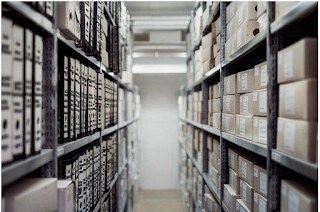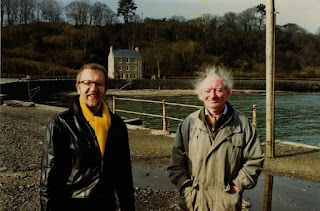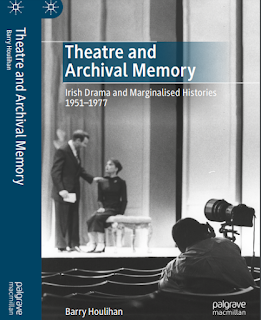Open Voices - Open Access and Archives: Publication, Collaboration, and Discovery
Open Access and Archives: Publishing, Collaboration, and Discovery
by Dr. Barry Houlihan, Archivist, NUI Galway Library
The work, opportunities (and challenges!) of open-access and archives are becoming increasingly entwined. Recent reports such as those published by the Royal Irish Academy, entitled Libraries and Archives and the Word Hoard by Siobhán FitzPatrick and Mary O’Dowd, media articles by Fintan O’Toole in which he decried Ireland as ‘a nation of historical vandals’ in the wake of lack of resourcing and care towards Ireland’s digital and physical heritage, and others, have made the case for increased digitisation of unique heritage collections, as well as for their digital preservation. Last month, in October 2021, the Irish Government published their ‘Project Ireland 2040’ document. Within the roadmap for the Department responsible for Arts and Culture (among many other portfolios) was the increased projection for digitisation of materials within national cultural institutions and broadly within the remit of the Decade of Commemorations only. While there is a clear necessity and appetite within national, academic, and public spheres for greater open-access digital content, the components of that particular Venn diagram do not always overlap neatly or easily in terms of planning, resourcing, and maintaining open-access digital archive and heritage projects.
 |
Within my own work, I encounter open-access publishing and the embedded place of archive material in a number of contexts. As an archivist, this first comes in two main strands – the first being in the processing, preservation, and dissemination of archival collections in various media and in various disciplines. The second is in the digitisation and publishing of archival collections, and on working through the consistent and efficient production of metadata and (born) digitised content made searchable online. Digital infrastructure, standards and workflows on such tasks are carefully managed by the Digital Publishing and Innovation team at the NUI Galway Library, and such cross-Library working teams ensure collaboration and communication across all skillsets required in bringing archive collections, through from the physical processing stage through to their online and digital presence. I work with a lot of researchers, from undergraduate students to senior academics, all of whom are seeking to engage with, learn from, and exploit archive material in new ways. All meet many similar barriers along the way, from open-access article processing costs, to infrastructure costs for onward project hosting, but yet the work is always greatly enhanced by the collaborative inclusion of archival research content or the data derived from its interrogation.
Such turn to the online open-access world ensures that the material usually held by one institution in one geographic location, becomes available to as wide an audience as possible, from academic and research communities as well as to the wider public. Given that so many archive collections are created of and relate to local communities, as well as national public histories, this is a delicate balancing act to ensure fair access as well as a representative and diverse array of digitally accessible online collections.
Secondly, as a researcher, I also encounter first-hand the many and varied tasks required that arise with using archive material in open-access or traditional publications, from journal articles to monographs. Within my own publications and projects, embedding open-access digital content, or indeed making entire projects open-access would be greatly desired, if not also not exactly straight forward to realise in reality. Material under copyright will require the clearing of any third-party rights, as well as possible publication charges by the copyright holder and/or by the holding institution. Rights are also then often required to be held in perpetuity by the publisher, in all formats, print and online, so there are tensions regarding striking a balance between the budgets and costs needed in order to reproduce archival content in publications/exhibitions, and the undoubted impacts and potential reach and engagement of having an open-access publication, which is greatly enhanced by its inclusion of newly available and digitised archival content.
Collaborative projects utilising archive collections at the NUI Galway Library and with international partners and an open-access ethos have proved especially successful. One recent example of such a project case-study is of the Tony-Award winning Joe Vaněk archive of theatre and opera design. Deposited at the NUI Galway Library in 2018, the Vaněk archive included a range of material unique to the designer’s perspective – notebooks of research, drawings and sketches, print-outs of online searches of visual material and emails, letters, as well as highly ornate holograph original costume and stage designs. The archive presented many opportunities to create an open-access digital archive. Crucially, the permission needed to clear all copyright in order for the collection to be made open-access was kindly given by the donor.
 |
| Joe Vaněk with Brian Friel |
The project also allowed for the extension of collaboration with international partners and funders. The Gate Theatre Research Network was a three-year project funded by the Dutch Research Council. Led by Universities at Nijmegen in the Netherlands, Charles University, Prague, Czech Republic, NUI Galway, and with a number of other universities across Ireland, the U.K., Europe, and the United States, the project brought together a number of scholars and projects related to the Gate Theatre and enabled by newly digitised archival resources, such as the Gate Theatre Digital Archive at NUI Galway.
These project links between Nijmegen and NUI Galway saw a researcher from the Netherlands, Grace Vroomen, spend a semester at Galway, who worked on digitising material from the Vaněk archive and working with Grace we curated a new online open access digital exhibition. Including over three-hundred digitised images, the exhibition also includes a number of contextual essays on five themes from the Vaněk archive, from European adaptation to the work of Brian Friel. This model expands on open-access digital archive by going beyond ‘just’ the high-resolution digital objects, to the creation and curation of an open-access learning resource on theatre and opera design, based on the archive of the Tony-award winning Joe Vaněk. The online exhibition becomes an immersive window into the designer’s eye and vision when creating and populating the world of theatre live on the stage. For the user, from the student to the academic to the practitioner, they have access to Vaněk’s notebooks and designs, as well as material on the reception and production of the work, from press cuttings, programmes, emails and letters and wider contextual information. As the archive material was scanned, descriptive metadata was sourced from the archive catalogue, with some additional metadata created and added to ensure maximum discoverability.
 |
| Costume design for Hollywood actress Holly Hunter by Joe Vanek |
As part of the Gate Theatre Research Network, an online conference was held to mark the project’s completion and launch the Vaněk archive and exhibition. An interview discussion was held with Vaněk, which was recorded and made available online, creating an oral history record with the archive creator, itself a unique and valuable contribution to the archive. A number of open access books were published by the project members stemming from the Gate Theatre Research project, including Cultural Convergence: The Dublin Gate Theatre, 1928–1960, edited by Ondřej Pilný, Ruud van den Beuken, and Ian R. Walsh (Palgrave MacMillan); A Stage of Emancipation: Change and Progress at the Dublin Gate Theatre, edited by Marguérite Corporaal and Ruud van den Beuken (Liverpool University Press); and a special issue of the open-access journal, Review of Irish Studies in Europe, on the theme of the Gate Theatre and Europe.
The Joe Vaněk online exhibition of theatre and opera design is available online here, with the full Vaněk archive catalogue online here.
For more information on the project and the archive, an article, A Stage of Transition: Locating European Identity, Culture and Memory at the Gate Theatre, was recently published by Dr. Barry Houlihan and Grace Vroomen in RISE journal (Review of Irish Studies in Europe) and which is part of an open-access special issue of RISE dedicated to the Gate Theatre and Europe.


Comments